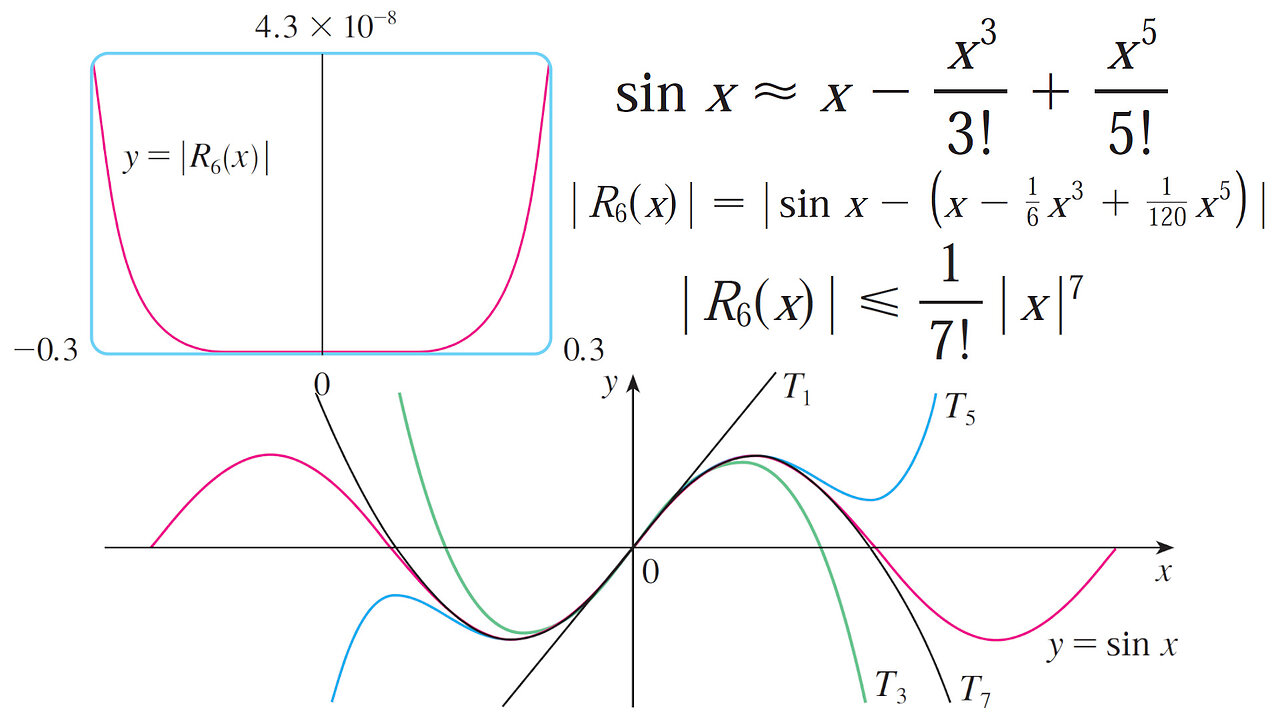Premium Only Content

Example 2: Approximating sin(x) with Taylor Polynomials and Calculating its Error
In this video I go over a very in-depth video exploring the trigonometric sine function, its Taylor polynomials approximation, and its associated error. The Maclaurin polynomial (Taylor series centered at a = 0) approximation has alternating signs, is decreasing, and the terms approach zero, thus we can use the Alternating Series Estimation Theorem to calculate the error. Later, I show that we can get the same result using Taylor's Inequality as well as via graphing the error directly with Desmos graphing calculator. When we approximate functions, it is important to center it near the value of x we want to approximate, because the series converges more rapidly. Lastly, I show how graphing multiple Maclaurin Polynomials for sin(x) get more and more accurate as we increase the number of terms, hence increasing the degree of polynomials.
Timestamps:
- Example 2: Error approximation for sin(x) Taylor polynomials: 0:00
- Solution to (a): Maclaurin series for sin(x): 0:41
- Maclaurin sine series is alternating when x is not zero: 2:03
- Can use Alternating Series Estimation Theorem to calculate the error: 5:02
- Absolute value of error is less than 4.3x10^(-8): 7:56
- Approximating sin(12 degrees) by converting to radians first: 9:41
- sin(12°) = 0.207912 correct to 6 decimal places: 13:09
- Solution to (b): Values of x to have accuracy less than 0.0005: 15:28
- Accuracy is within 0.0005 for when the absolute value of x is less than 0.82: 18:55
- Example 2 using Taylor's Inequality: 20:27
- Solving for 7th derivative of sin(x): 22:10
- Taylor's Inequality gives same result as the Alternating Estimation Theorem: 23:52
- Graphing the Remainder Function with Desmos: https://www.desmos.com/calculator/yphi6wpizp: 27:24
- Error is less than 4.3x10^(-8) just as in Part (a): 29:49
- Graphing Remainder function and y = 0.00005 in Desmos: https://www.desmos.com/calculator/5uuyhdlp1y: 30:58
- Interval of error is between absolute of x less than 0.82 just like in part (b): 31:48
- For different angles we can use Taylor Polynomials centered at different values of x: 32:56
- Graphing various Maclaurin polynomials for sin(x) using Desmos: https://www.desmos.com/calculator/8pl3nc2zha: 33:33
- The Maclaurin polynomial with the most terms is the most accurate: 35:22
- Taylor Polynomials are used in Calculators and Computers to solve functions like sine and e^x: 36:58
Full video, notes, and playlists:
- Full video and playlist: https://www.youtube.com/playlist?list=PLai3U8-WIK0F76sIU8xm09oqBTq1mlry3
- HIVE notes: https://peakd.com/hive-128780/@mes/infinite-sequences-and-series-applications-of-taylor-polynomials
- Infinite Sequences and Series: https://www.youtube.com/playlist?list=PLai3U8-WIK0EXHAJ3vRg0T_kKEyPah1Lz .
------------------------------------------------------
Become a MES Super Fan! https://www.youtube.com/channel/UCUUBq1GPBvvGNz7dpgO14Ow/join
DONATE! ʕ •ᴥ•ʔ https://mes.fm/donate
SUBSCRIBE via EMAIL: https://mes.fm/subscribe
MES Links: https://mes.fm/links
MES Truth: https://mes.fm/truth
Official Website: https://MES.fm
Hive: https://peakd.com/@mes
Email me: contact@mes.fm
Free Calculators: https://mes.fm/calculators
BMI Calculator: https://bmicalculator.mes.fm
Grade Calculator: https://gradecalculator.mes.fm
Mortgage Calculator: https://mortgagecalculator.mes.fm
Percentage Calculator: https://percentagecalculator.mes.fm
Free Online Tools: https://mes.fm/tools
iPhone and Android Apps: https://mes.fm/mobile-apps
-
 3:10:29
3:10:29
Math Easy Solutions
4 days ago $0.01 earnedMES Livestream 73: Agenda 2030 Deep Dive
3591 -
 1:46:16
1:46:16
Redacted News
3 hours agoRFK CONFIRMATION: Kennedy goes to WAR with Big Pharma Democrats in Fiery Hearing | Redacted Live
80.8K209 -
 57:31
57:31
Candace Show Podcast
3 hours agoBREAKING! Taylor Swift Turns Against Blake Lively & Ryan Reynolds | Candace Ep 141
104K143 -
 LIVE
LIVE
Sarah Westall
1 hour agoRFK Jr Report, Constitution Suspended, War Time Procedures in Place, WHO Exit, DOD w/ Sasha Latypova
578 watching -
 LIVE
LIVE
Melonie Mac
4 hours agoGo Boom Live Ep 35!
438 watching -
 1:01:13
1:01:13
LFA TV
8 hours agoPRESIDENT TRUMP SIGNS LAKEN RILEY ACT | BASED AMERICA 1.29.25 6pm
6.99K4 -
 LIVE
LIVE
2 MIKES LIVE
2 hours ago2 MIKES LIVE #172 News Breakdown Wednesday!
236 watching -
 LIVE
LIVE
The Big Mig™
3 hours agoJ6’r Ryan Samsel Free At Last The BOP & DOJ Exposed
1,735 watching -
 DVR
DVR
The Based Mother
3 hours agoEXECUTIVE ORDER MUTILATES GENDER IDEOLOGY! Trump’s pulling out all the stops.
48 -
 1:05:44
1:05:44
The Amber May Show
20 hours ago $0.10 earnedSaving The Innocence | Rescuing Children From Rape Trafficking | Alan Smyth
5.32K3